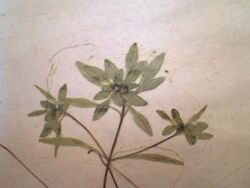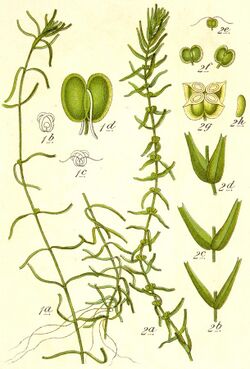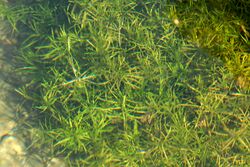Biology:Callitriche hamulata
| Callitriche hamulata | |
|---|---|

| |
| Scientific classification | |
| Kingdom: | Plantae |
| Clade: | Tracheophytes |
| Clade: | Angiosperms |
| Clade: | Eudicots |
| Clade: | Asterids |
| Order: | Lamiales |
| Family: | Plantaginaceae |
| Genus: | Callitriche |
| Species: | C. hamulata
|
| Binomial name | |
| Callitriche hamulata Kütz. ex W.D.J. Koch
| |
| Synonyms[1] | |
|
Synonyms
| |
Callitriche hamulata is a species of flowering plant belonging to the family Plantaginaceae.[2]
Description
It is a submerged plant with slender, branching stems about 20–70 cm (8–28 in) long. The light green, narrow leaves are up to 6 cm (2 in) long and 1-2mm wide, slightly broadening at the tip. The leaves which can float on top of the water, are shorter and wider, they are also light brownish or pinkish green.[3] It has tiny inconspicuous green flowers and fruits,[4] and has a flowering period of between May and October.[5] or between April and September in the UK.[4]
Taxonomy

It was then described by Wilhelm Daniel Joseph Koch before being widely published by Friedrich Traugott Kützing in 'Synopsis Florae Germanicae et Helveticae' Collection 246 in 1837.[1][6]
The Latin specific epithet hamulata is derived from hamatus meaning "with hooks" or "hooked",[7] referring to the hooked end of the leaves.[5]
Distribution

Callitriche hamulata is native to a wide area, which stretches from Greenland,[2][8] and Iceland,[3] through Europe to North-western Africa.[2]
It is widespread and fairly frequent in Britain, particularly in south eastern England.[4]
Habitat
It is found in rapidly flowing streams,[9] which are well oxygenated, and freshwaters, from sea level to about 1,200 m (3,900 ft) above sea level.[5] This plant can grow in shallow waters and can also adapt to a deeper water level, especially after flooding.[3] It can also be found in or near ponds, ditches, in still or slow moving water.[4]
References
- ↑ 1.0 1.1 "Callitriche hamulata Kütz. ex W.D.J.Koch is an accepted name". theplantlist.org (The Plant List). 23 March 2012. http://www.theplantlist.org/tpl1.1/record/kew-31590. Retrieved 21 April 2020.
- ↑ 2.0 2.1 2.2 "Callitriche hamulata Kütz. ex W.D.J.Koch | Plants of the World Online | Kew Science" (in en). https://powo.science.kew.org/taxon/urn:lsid:ipni.org:names:430002-1.
- ↑ 3.0 3.1 3.2 W. Vivian De Thabrew A Manual of Water Plants, p. 43, at Google Books
- ↑ 4.0 4.1 4.2 4.3 "Intermediate Water-starwort". http://www.naturespot.org.uk/species/intermediate-water-starwort. Retrieved 27 December 2016.
- ↑ 5.0 5.1 5.2 "Callitriche hamulata Kütz. ex W.D.J. Koch". http://dryades.units.it/stagnisardi_en/index.php?procedure=taxon_page&id=4404&num=3170. Retrieved 27 December 2016.
- ↑ "Callitriche hamulata | International Plant Names Index". https://www.ipni.org/n/430002-1.
- ↑ Brown, Roland Wilbur (1956). The Composition of Scientific Words. Washington, D.C.: Smithsonian Institution Press. p. 420.
- ↑ Jon Feilberg A Phytogeographical Study of South Greenland Vascular Plants (Bioscience 15, 1984), p. 13, at Google Books
- ↑ S. M. Haslam and P. A. Wolseley River Vegetation, Its identification, assessment and management, p. 46, at Google Books
Wikidata ☰ Q164986 entry
 |

